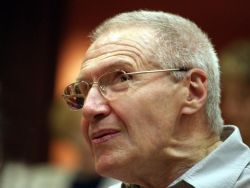|
Symphony
SRS SEASON ENDS WITH RESOUNDING TA-TA-TA-BANG
by Terry McNeill
Sunday, June 1, 2025
Symphony
YOUTHFUL VIRTUOSITY ON DISPLAY AT USO'S MAY CONCERTS
by Peter Lert
Saturday, May 17, 2025
Symphony
MYSTICAL PLANETS AND LIVELY GERSHWIN ORTIZ AT FINAL SRS CONCERT
by Peter Lert
Sunday, May 4, 2025
Symphony
VSO'S CONCERT MUSIC OF TIME, MUSIC OF PLACE
by Peter Lert
Sunday, April 27, 2025
Choral and Vocal
VOCAL ELEGANCE AND FIRE AT THE 222'S RECITAL APRIL 26
by Pamela Hicks Gailey
Saturday, April 26, 2025
CANTIAMO SONOMA SINGS AN INSPIRED GOOD FRIDAY MOZART REQUIEM CONCERT
by Pamela Hicks Gailey
Friday, April 18, 2025
DRAMATIC SHOSTAKOVICH SYMPHONY CLOSES PHILHARMONIC'S 25TH SEASON
by Terry McNeill
Sunday, April 13, 2025
LARGE COLLEGE OF MARIN AUDIENCE GREETS STOPHER ARTISTRY
by Terry McNeill
Saturday, April 5, 2025
Chamber
FRISSON DELIVERS SHIVERS OF DELIGHT
by Abby Wasserman
Sunday, March 30, 2025
OLD AND MOSTLY NEW IN SRS MARCH CONCERT IN WEILL
by Peter Lert
Saturday, March 22, 2025
|
 |
 Composer Gyorgy Kurtag |
TWO STEPS FORWARD, ONE BACK
by Steve Osborn
Sunday, November 8, 2015
Santa Rosa Symphony’s Nov. 7 concert ran the gamut, not only from new to old, but also from impassioned to inert. The new was Gyorgy Kurtag’s “...quasi una fantasia...”; the old were the Schumann piano concerto and Brahms’ first symphony. The Brahms and Kurtag performances were lively, but the Schumann was moribund.
Let’s start with the lively ones. “...quasi una fantasia...” was clearly unusual even before the music began. Instead of the standard orchestral seating arrangement, the chairs were shuffled around into five groups. The first group was a semicircle of chairs and piano at the front of the stage. Behind that semicircle, four other groups of chairs were scattered about the stage in a seemingly random pattern.
Another deviation from the norm was the absence of musicians, even when the lights went down. After a brief pause, they finally filed onto the stage and settled into their respective groups. The semicircle comprised a handful of strings and the piano on stage right, woodwinds in the middle, and brass on stage left, opposite the strings. The other groups were mostly percussion, but one was a collection of harmonica players.
Conductor Bruno Ferrandis briefly explained the four short movements of the piece, and then the musicians got to work. The sound from the beginning was distinctive, with a halo of percussion around slow and low descending notes beginning in the piano. The harmonicas and a marimba added to the unusual texture, which was simultaneously thick and delicate.
The second movement began with heavy percussion and then segued into the third, a deliberate march, as if to a funeral. Nearly all the instruments soloed briefly as the march proceeded relentlessly in the background. The last movement featured dense sonorities that required full attention. The descending scales appeared again, resolving into a final wash of sound from the harmonicas. “...quasi una fantasia...” lasts just nine minutes, but each one is packed with innovation and surprise. It was the perfect foil for the older works on the program, demonstrating that contemporary works can equal or even surpass the classics.
One of those classics occupied the second half. Brahms’ first symphony is an oft-repeated gem of which audiences never seem to tire. Perhaps that’s because all the parts are so authoritative and finely honed that they feel like the building blocks of a mighty fortress. Musicians, however, still have to breathe life into the parts and make sure they fit together.
The musicians at hand proved up to the task, digging in with gusto from the opening bars. The strings began each new phrase with an emphatic down-bow and bowed in unison with nary an outlier. Ferrandis infused the performance with drama by pushing tempi and eliciting pinpoint crescendos and diminuendos. At one point the syncopations got so intricate that several musicians began tapping their toes.
The unanimity of sound and pace was impressive, and the many solos were a delight. One of the standouts was the violin and horn duet in the slow second movement. Concertmaster Joseph Edelberg hit all the high notes, and Alex Camphouse's French horn articulation and phrasing were superb. The symphony hurtled forward with only brief pauses between the movements and really began picking up steam in the finale. The spark was the resonant and accelerating pizzicato at the opening, followed by heroic playing from the horns and woodwinds, and then the memorable theme. Ferrandis has a real gift for driving the orchestra forward, and drive them he did, right to the spine-tingling close.
In Schumann’s A Minor concerto, piano soloist Pedja Muzijevic was technically perfect but demonstrated little passion or projection. He sat straight at the keyboard and came down heavy on the pedal. The sound that emerged from the lid was precise but curiously muted, almost as if under water. At times the orchestra drowned him out.
Muzijevic's technique, however, was awesome. His fingers flew across the keys and fluttered so rapidly that they often seemed to be floating above the keys rather than striking them. All the notes were there, but they never ignited. Schumann is a composer who demands fire, yet there were no flames in evidence, not even smoke, and the performance became a mere collection of notes.
|
